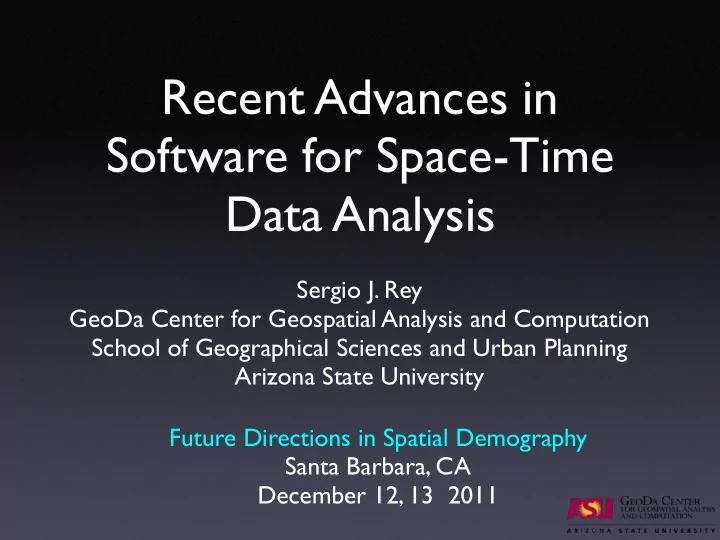

Recent Advances in Software for Space-Time Data Analysis Sergio J. Rey GeoDa Center for Geospatial Analysis and Computation School of Geographical Sciences and Urban Planning Arizona State University Future Directions in Spatial Demography Santa Barbara, CA December 12, 13 2011
Acknowledgments • Economic Development Administration • National Institutes of Health • National Institute of Justice • National Science Foundation
Outline • Evolution of space-time analysis software • PySAL: spatial dynamics • Challenges
Evolution
Space-Time in GIScience • Representation • Data Modeling • Geovisualization • Spatialization • Geostatistics
Space-Time Domains • Tracking • Change Detection • Polygon Coverages • Agent Based Models • Cellular Automata • Events Goodchild, M.F. (2010) GISRUK Keynote
“Ancient History” • Space-Time Identified as Future Theme • Dynamics of spatial clustering • Clustering of temporal co-movements • No specialized packages in existence
STARS Space-Time Analysis of Regional Systems
Brushing and Linking
Space-Time Path and Time Traveling
Distributional Leap Frogging and Spatial Travel
Spatial Markov
PySAL Python Spatial Analysis Library
History • Spatial Analysis Laboratory (UIUC) • Regional Analysis Laboratory (SDSU) • STARS • GeoDa • Various other projects
Uses of PySAL • Platform agnostic • Shell • Desktop Applications • GeoDaSpace • STARS • Plug-ins (ArcGIS, QGIS) • Distributed services, Web apps
Pedagogic Goals • Code as text • no black boxes • replicability • Extensive documentation • tutorials/API • cultural shift
Performance: Weights Creation
ESDA • Measures of spatial autocorrelation • Moran’s I, Geary’s c, join counts • Map Classification • Natural breaks, Fisher Jenks, equal interval, more • Rate smoothing • Empirical Bayes, age adjusted, excess risk, more
Inequality • Theil Index • Entropy based measure of spatial inequality • Regional decomposititons • Interregional inequality • Intraregional inequality
Regionalization • max-p (Duque, Anselin, Rey 2012) • Given n areas, form the maximum number (p) of regions respecting contiguity and threhsold constraints • Random Regions • Randomly construct regions given various constraints
Spatial Dynamics • Markov transition matrices • Classic, spatial, LISA • Space-time interaction tests (1.2) • Knox, Mantel, Jacquez • Space-time Rank mobility tests • Space-time LISA • Directional LISA • (Rey, Murray, Anselin 2011)
Directional LISA
LH HH LL HL
Directional Moran Scatter
Origin Standardized
Segment Count Expected p-norm p-rand s z 1 19 18.157 2.356 0.358 0.360 0.432 2 13 9.141 1.940 1.989 0.023 0.041 3 3 4.587 1.412 -1.124 0.131 0.233 4 2 6.947 1.720 -2.876 0.002 0.010 5 7 1.924 1.467 3.460 0.000 0.005 6 2 0.543 0.720 2.024 0.021 0.092 7 1 1.223 1.019 -0.219 0.413 0.638 8 1 5.478 2.060 -2.174 0.015 0.013 Table 1: Conditional randomization tests of directionality
Bivariate LISA
Bivariate LISA Hallahan, C. (2009) SIGSTAT
Bivariate LISA • Consistent with diffusion • inward • outward • Also consistent with stable spatial autocorrelation • Does not distinguish between • apparent diffusion/contagion • true diffusion/contagion
LISA Markov
LISA Markov • LISA = Local Indicator of Spatial Association (Anselin, 1995) II I III IV • LISA Markov (Rey and Janikas 2006)
LISA Markov • 4 states for the chain: HH, LH, LL, HL • 16 possible transitions over one time interval • characterize spatial dynamics • diffusion/contagion • directionality
t1 t2 Dynamics HH HH stability HH LH own suppression HH LL concurrent suppression HH HL other suppression LH HH inwards contagion LH LH stability LH LL outwards suppression LH HL inwards displacement LL HH concurrent increase LL LH potential inwards LL LL stability LL HL potential outwards HL HH outwards contagion HL LH outwards displacement HL LL inwards suppression HL HL stability
Text Crime Analytics for Space-Time
Challenges
MAUP in Space-Time • Most (all?) MAUP attention on cross- sectional case • Aggregation and zoning components • In space-time: more complex • appearance of new counties • annexations • split/merging of census tracts
Responses • Longitudinal Studies (common) • areal interpolation to time-consistent and exogenous boundaries • Endogenous boundaries (future) • space no longer exogenous container • predicting tract splits/merger • predicting redistricting • predicting state formation
Software • CyberInfrastructure • Enormous potential in hpc/parallelization • Substantial refactoring required • GUI - Putty/Clay • Need for extensible/flexible toolkits • New methods will likely be required • Scientist as producer rather than consumer
PySAL • Next release: Jan 31, 2012 (1.3) • Google Code • Feature requests • Bug reports • Get involved • Feature requests - what would spatial demographers want/need?
http://pysal.org geodacenter.asu.edu twitter.com/GeoDaCenter www.facebook.com/geodacenter
PySAL 1.3+
Python 3.x • Changes • Python 2.x series ends with Python 2.7 • Many backward incompatible changes in Python 3.x • New Python functionality only in 3.x • PySAL was written for Python 2.x • Tests of current PySAL code base shows broad compatibility with Python 3.x
Parallel PySAL • Integration with CyberGIS project • plisa • Focus at ASU • Examining parallel mechanisms in Python • Mapping of PySAL spatial analytical components to alternative parallel mechanisms • Multiple implementations for delivery
Contrib Module • New in 1.3 • Leverage third party libraries • Avoid core dependencies • Libraries • Shapely • proj4
Recommend
More recommend